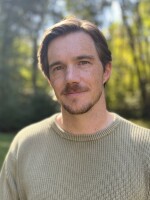Growing up in the small town of Wadsworth, Illinois, Patrick Read Johnson was enthralled, some might say obsessed, with making movies. As a teenager in the 1970s, movies like “2001: A Space Odyssey” and “Jaws” inspired Johnson to make Super 8 movies with his friends in his garage, using any prop or special effect Johnson could concoct. But during a trip to Hollywood, Johnson’s life changed forever when he saw a rough cut of “Star Wars” in the spring of 1977. Johnson was blown away when the movie hit theaters, and was propelled to continue making movies.
Over the years, Johnson would go on to write and direct films like “Spaced Invaders” and “DragonHeart.” Now, he has released a semi-autobiographical film called “5-25-77” about his admiration for movie making and the influence of “Star Wars” on his work. Host Frank Stasio talked with Johnson about making movies as a kid and seeing “Star Wars.”
INTERVIEW HIGHLIGHTS:
Johnson on growing up in Wadsworth, Illinois and getting into filmmaking as a kid: I was living in kind of a broken home, or a home that was breaking up. My mother and father were not getting along well. He had a Super 8 movie camera that he kept in the closet and [would] bring out for all the family occasions. When he was at work during the day, I’d steal it and go to my basement … Or wherever I happened to have a model set up or a train set or some rocket or airplane I’d built that I could light on fire for a World War II movie or spaceship explosion. Things escalated from there because my friends enjoyed it. There wasn’t much for them to do either, but if they could act in one of these silly films and pretend they were the Bionic Man or pretend they were one of the Planet of the Apes apes was a fun thing for them to do.
On going to Hollywood and meeting the editor of “American Cinematographer” magazine Herb Lightman and special effects specialist Douglas Trumbull: Herb takes me to meet Douglas Trumbull, and Douglas was so busy running around all over Hollywood getting things done for “Close Encounters of the Third Kind” that he wasn't actually at the facility he was supposed to be at when we got there. So instead, we had to settle for meeting, um, what was his name? He was this young kid and looked 11 and had just directed “Jaws.” Oh right, Steven Spielberg! That scene was amazing and really happened … He introduces himself in a really unique and lovely fashion and makes me feel incredibly welcome. The problem is he and Douglas are creating [‘Close Encounters of the Third Kind’] like NASA engineers, like nuclear physicists. Everything is planned to the nth degree. It is brilliantly engineered and scientific. It is work. And I’ve been making movies in my garage my whole life and doing whatever the hell I wanted – like turning hubcaps into flying saucers and hanging my brother from the ceiling in a space suit to make weightlessness and then forgetting he was there. So I literally leave a sit-down with Steven Spielberg because I’m basically hyperventilating with fear of not being able to do this and of not fitting into this world at all.
On stumbling upon the set of “Star Wars” with Herb Lightman: On the drive home [after meeting Steven Spielberg], Herb is basically like, ”Maybe you should go to Universal Studios tomorrow to see how they really make movies, or why don’t you go to Disneyland?” He’s basically picking on me, and I said, “No, I came here to see everything I could.” And Herb goes, “Well, you probably don’t want to come with me tomorrow. I’m going to see these college kids that are goofing around in a warehouse in the San Fernando Valley trying to make a space movie and everybody thinks they are crazy. Get this, it’s called ‘Star Wars,’” he says ... So we go out, and we arrive at this parking lot filled with Death Star surface panels all tilted up on their sides. And we don’t know what it is, because nobody knows what a Death Star is, because no one knows what “Star Wars” is. So it’s a strange alien landscape of expanded-urethane-foam Death Star surface and a bunch of hippies racing radio-controlled cars around and one guy sitting in a hot tub made out of a camera case sunning himself and smoking a joint. And I’m like, “Okay, first of all, I don’t know if they’re making a good movie here, but they do look like the kids in my neighborhood, so maybe I could fit in here.”
On meeting John Dykstra, the special effects specialist for “Star Wars”: [John Dykstra] throws open this door and drags us into this giant black-draped room – this warehouse that is like somebody took my garage and fed it steroids. It’s just shelves of model kits and paints and glue everywhere. Things are a mess, and it’s this place of creativity, but it's all improvisational. You can see as John Dysktra says in the film, “Look kid, we’re making this whole movie out of things you can find in your garage.” And it’s true. The entirety of “Star Wars” is a big kluge job of things that were found and repurposed. And suddenly I realize that this could be something.
“5-25-77” screens Thursday at 7:30 p.m. at North Hills Stadium 14 in Raleigh. View a trailer for the film below:
https://www.youtube.com/watch?v=RZwBzUWZGS4




